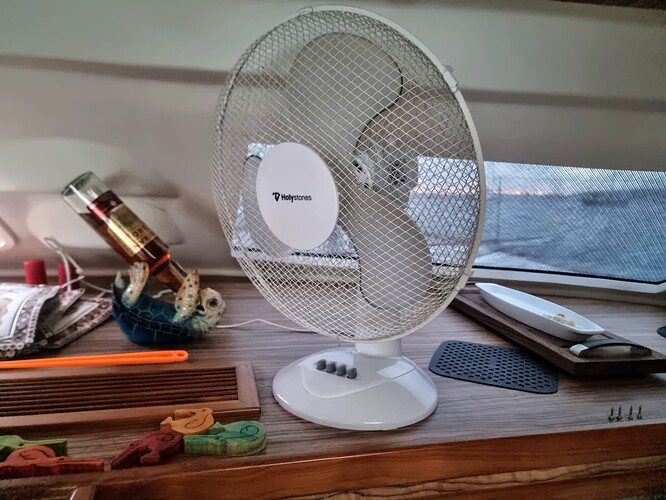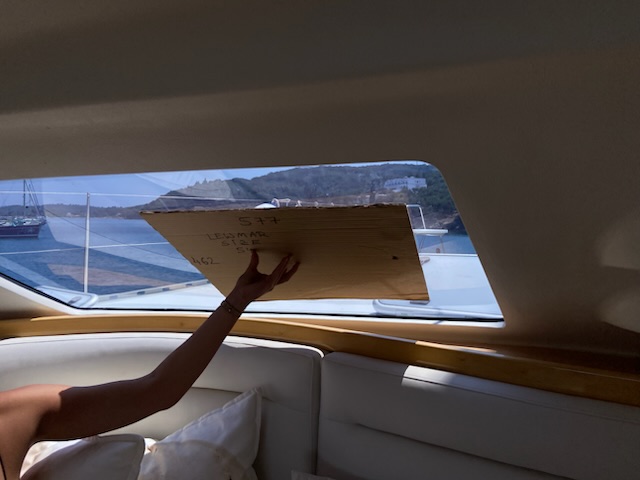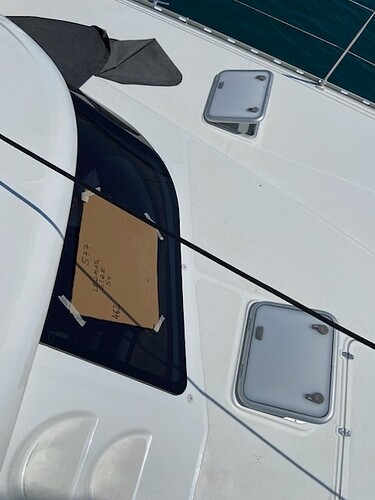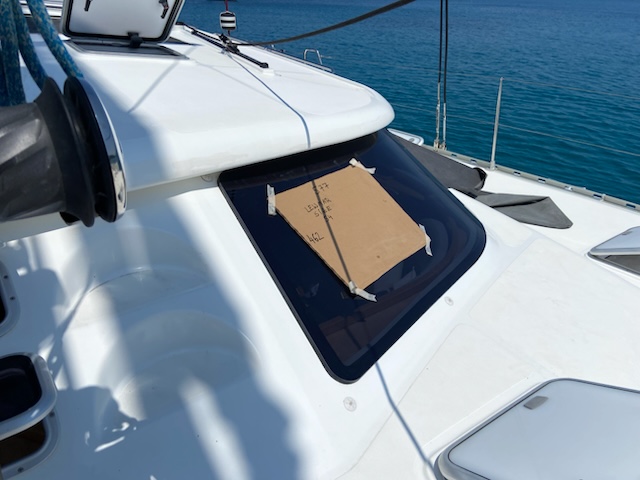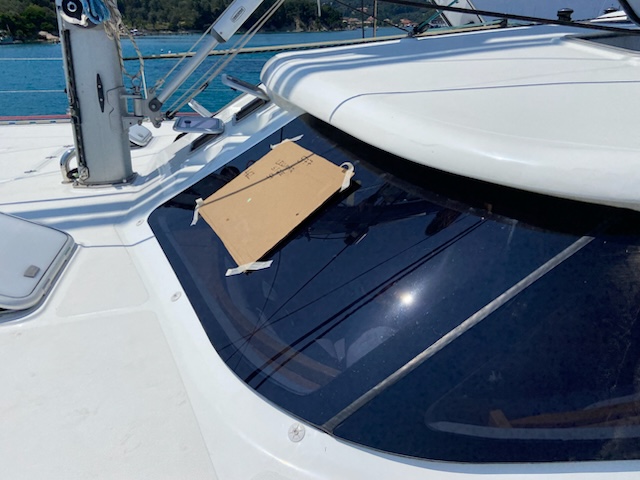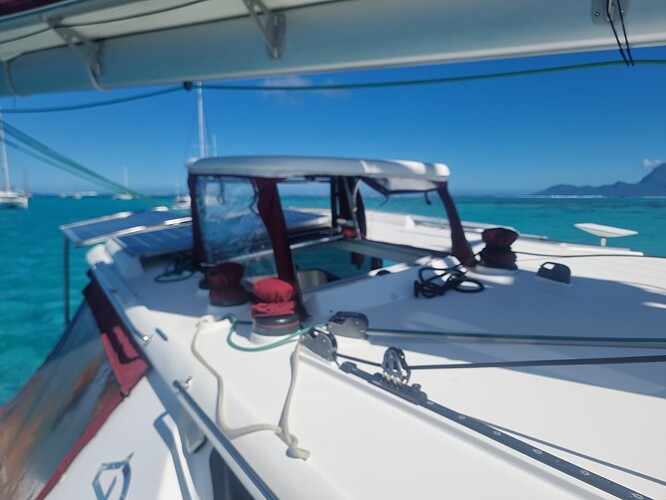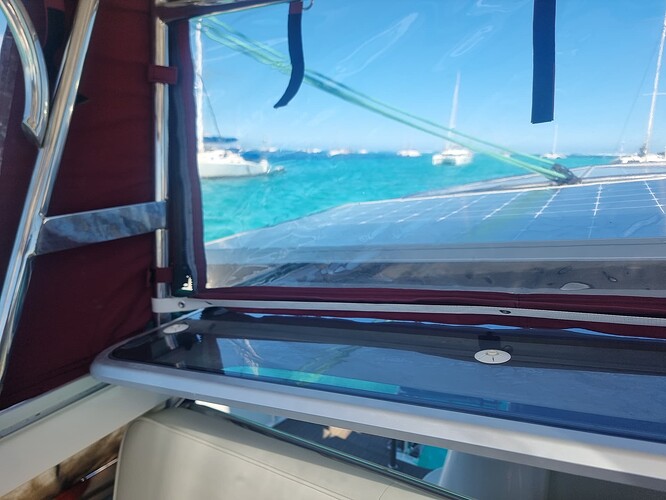It is getting hotter on the planet, we feel it a lot in the Mediterranean.
Therefore we discussed how to get a better ventilation on Bahati. Hiding from the heat in the cabins with the A/C on is not a good option. Anchoring with a stern anchor to have the breeze from the back?
Maybe modifying the two main windows and install into these windows (or replace them with) hinged hatch windows to scoop the air in? Whoever contemplated about such a modification please share your thoughts.
I have often contemplated this too. We live in the tropics and like you we don’t like to shut ourselves away and close the doors with aircon on.
Whilst I love the concept of big forward facing opening windows like some of the newer design cats are fitting - and whilst I have contemplated it many times - I can’t see an easy option to fit them. The windows are glass which is laminated and curved (very specialist and expensive). It would take a braver man than me to start drilling and cutting them to put hatches in - and it would disrupt the “flush” lines.
Big forward facing hatches would also be a concern for me in heavy weather and the starboard one would be very difficult to reach on our boat.
Having just spent five and a half months in a marina the best we have done ventilation wise is a 230v desk fan… Which makes a huge difference in the main cabin.
I have also contemplated a custom wind scoop for the two small hatches behind the mast to funnel air to them using the mast and maybe a spingy fibreglass rod to support the front edge.
I’m also considering how to avoid the heat in the cabin in the first place.
We have the mesh window blinds that Knysna produce - and whilst these do help a lot with the direct heat, I am thinking of a Mk 2 version to incorporate an air gap between blind and glass - even with the blinds fitted our windows still get super hot. I’m thinking a bolt rope track just under the coach roof and maybe hooks for bungee along the bottom edge allowing a 50-100mm air gap.
Keeping the sun off the coach roof also helps. I am contemplating adding a coach roof tent. We have the hay rack on our boom so it’s easy to attach a shade tent along that and take it down to the handrails. Having been aboard a boat that did something similar it made a huge difference inside. Obviously if you have deck mounted solar panels then there is a conflict (we don’t have any). We often tie our boom out to one side to avoid shading the rear solar panels so I need to think through if I get the shade tent made for that configuration or go with a centralised boom.
At least we get some cloud cover here in the tropics which I know is very rare during the Mediterranean summers. Now I have revisited this again I foresee some jobs on my list when we get to New Zealand!
I have considered removing and reinstalling the aft cabin hatches so they open at the front, not the back. When on anchor the wind almost always is on the nose, so having aft opening hatches is not the smartest idea.
We bought these for the big cockpit hatches but never got around to adapting it for the openings.
We were going to cut the bottom out and put snaps on the edges and roof so it could be snapped in. We had several wind scoops for other hatches, which were very good.
I have seen many new performance boats with large opening windows but I wonder…Are they always blessed to be in environments without any insects? I haven’t seen any screens for these , usually very large windows.
I have just bought two of the “Quechua” and try them.
Great idea to use a standard shade tent with flexi poles. This might make it unnecessary to hang the wind collectors to hlayards and shrouds.
Did you play around with any other wind scoops? If you have pictures and product links please share them.
If there are no custom fly screens coming with the hatches I am using standard mosquito netting with a curtain weight string sewed into the fabric. Then just place it over the open hatch - only works with horizontal hatch installations.
Thanks for all your elaborated feedback.
The heat and ventilation became such an issue that we even discussed getting a Leopard. The new Leopard design allows to open the front door and the wind is blowing right through. I did hear from Leopard owners that the ventilation is fantastic.
We have bought two standard automotive aluminium foil covered shades which we put behind the KYC window blinds on Bahati. Forward vision gone, but it reduces the heat in the main cabin drastically. One could cut holes in the shades to have some holes to look forward. Not an elegant solution but it helps. On Bahati the inside of the coach roof does not get hot - so no problem for us and no need to shade the roof from the outside.
The Knysna has a ‘different compared to the usual’ and beautiful designed shape which one would not like to disrupt. However a modification of the “flush” lines might be better compared to the punishing heat.
We are seeking a ventilation solution which is better than a fan. As you know the heat is not only in the main cabin but as well in the outside area around the table. On anchor, the wind does not reach this area.
Installing into the windshields standard hatches which can be opened might be the most cost effective method which does not require to design and reengineer a whole new windshield. However you mentioned that it might be difficult to cut (with a jigsaw) the (laminated?) plastic glass. Do you know specs of the glas? I am not sure if such a solution might compromise the stability of the windshield. However, I would imagine wind and wave load would not be that much. Maybe KYC would be able to comment.
Another thought is to cut open and install a big hatch into the roof of the main cabin but again, would it compromise the roof structure or interfere with the main sheet? Modifying the sliding hatch in the aft area in a way that it tilts up might scoop substantial amounts of air into the back. Combined with custom made wind scoops like you suggested and around the helm roof might improve ventilation. For now I have ordered the ‘Quechua’ camping shelters and will try how these will work to scoop some air.
I did send this email to KYC today:
*Dear Grant, dear Carel and KYC technical team,
I hope you are all well and I do send you greetings from BAHATI. Whenever I am skippering this beautiful boat my engineering mind is triggered even when the brain is melting in the heat of the Ionian Sea. The heat is a serious issue for us and we are currently trying and considering different solutions to improve ventilation in the main inside and the main outside areas.
It seems we are not the only ones contemplating what could be done and some ideas have been already exchanged on the Knysna forum (Ventilation - #7 by Bahati)
We are currently contemplating to install a standard Lewmar hatch (size 54) into each front windshield window.
It would be great if your engineering and installation team could give feedback:
** Has KYC ever considered installing hatches in the main windshields or are there even other ventilation improvement solutions we do not know about?
** Would it be possible to retrofit Lewmar hatches (size 54) or would this compromise the structure of the glas or the stability against wind and waves?
** What material is the windshield glas made out of? What kind of plastic is it and is it laminated?
** Would it be possible to cut out the hatch holes with a standard jigsaw and obtain a clean cut? What jigsaw blades and cutting speed should be used? Would the glas delaminate at the cutting area? What kind of drills and speeds to use for the holes? What kind of material to use to glue the hatch frame to the glas, e.g. Sikaflex XYZ?
** The length/width of the hatch could be bigger. However it seems that the biggest standard rectangular Lewmar size is the size 54. Do you know of bigger rectangular Lewmar hatch sizes? Is it possible to get custom sizes or would the prices be exorbitant?
** Would you recommend a ‘Low Profile’ or a ‘High Profile’ Lewmar hatch?
Please refer to technical specs PDF of the Lewmar hatches and the pictures below with the Lewmar hatch (size 54) template.
BAHATI Lewmar hatch size 54.pdf (3.9 MB)
Thanks for your support
We had several of these.
https://defender.com/en_us/breeze-booster-hatch-ventilator
Some catamarans have installed the vinyl window covering in a fine dot pattern to reflect light but allow views out.
A trick Brivan taught us is to open the escape windows at anchor. This provided a lot airflow.
No rain would come in either, which was a plus.
I believe the windows are actually made of curved glass not plastic.
Also, one other thing we do at anchor when we are head-to-wind is to put the side and back screens of the helm position downs - with the windshield open. That creates a big wind-scoop into the cockpit.
I have made a custom strap across the back edge to hold the poppers on the rear screen down - rather than clipping them to the sliding hatch. That allows us to close the hatch with the screens down and stops it flapping and tapping. .
Unfortunately, we received the following answer from KYC. Therefore we cannot install the hatches as planned.
Please read comment below from our designer:
The K500 windows are all floated glass. While it is toughened, any drilling or cutting into the glass will crack it, so I do not advise this.
Some competitor boats make use of acrylic (polymethylmethacrylate, PMMA) for their windows. This is a ‘plastic’ which allows for the installation of Lewmar type hatches. It however does not provide the visual clarity expected on KYC vessels, hence why KYC vessels make use of glass.
If a boat owner would prefer to give up the visual clarity of the glass windows for ventilation. I would recommend replacing the glass windows with an acrylic window. This is easier said than done though, as the majority of the saloon windows are curved which would require a custom made acrylic. The flat windows however could be cut from a flat acrylic sheet. I would recommend a 10-12mm thick ‘Plexiglas GS’ from Maizeys.
Lewmar’s largest standard rectangular hatch is the 54. The square hatches get as big as size 70.
